Abstract
Guide vanes (GVs) are installed between the runner and the stay vanes for flow guidance and discharge regulation in reversible pump-turbines. The unstable torsional self-excited vibration of the guide vane (GV) may occur when running at small guide vane opening angles during the transient operations involving pump flow. In addition, the double-stage radial vanes may induce complex flow in the vanes and influence the stability of torsional self-excited vibration of the guide vane. In this study, numerical simulations were conducted at small guide vane opening angles in pump mode for two different guide vanes based on the three-dimensional computational fluid dynamics (CFD) method. The flow regime with a deflection was formed on the trailing edge with a circle in the vaneless region that rotated reversely against the runner rotation when operating at smaller guide vane opening angles for both of the two guide vanes. Based on this, the coupling simulations based on the CFD method with a single-degree-of-freedom (1DOF) oscillator were carried out under these operating conditions. Two flow types were formed at small opening angles when adopting different inlet boundary conditions. The results showed the flow regime with a deflection on the trailing edge may aggravate the instability of torsional vibration when applied as an initial flow field. Moreover, the vibration instability of the torsional self-excitation for two guide vanes was analyzed, showing that modifying the profile of guide vane airfoil is an efficient and reliable approach for weakening the torsional vibration instability.
1. Introduction
As more renewables come online, energy storage technologies are widely required to handle variations in electrical power systems. Of these technologies, hydropower pumped storage using reversible pump-turbines is very convenient for engineering applications and has been recognized as the only commercially available grid-scale technology at present [1]. As the key components of pumped storage power (PSP) plants, reversible pump-turbines can be applied for load-leveling by pumping water if the energy supply is higher than the demand and generating electricity when the demand is higher than the supply. In addition, this technology also benefits the electrical power system with grid frequency regulation and spinning reserves [2]. However, pump-turbines constantly experience transitional processes such as startup, shutdown, power failure, load rejection, and emergency shutdown [3,4]. These processes usually accompany dynamic instabilities causing cracks or even failures of the penstocks or the hydraulic system. Since these operations would occur many times in a week, or even a day, the reliability and safety of pump-turbines need to be ensured at all levels aiming to reduce the maintenance costs.
In reversible pump-turbines, GVs are installed between the runner and the stay vanes for flow guidance and discharge regulation [5,6]. The double-stage radial vanes increase the complexity of flow passage, which may induce extra flow problems such as the inter-vane jet flow and the stalled flow pattern in the vanes [7,8,9]. In addition, GVs may experience strong vibrations in both normal steady-state operating ranges and transient processes [10,11,12]. The flow characteristics such as rotating stalls, von Karman vortex, and rotor-stator interaction (RSI) are known for promoting large pressure fluctuations in pump-turbine and causing GV vibrations through fluid-structure interaction [13,14]. Abnormal sounds and vibrations occurred in the GVs of pump-turbines during the pump-starting and pump-closing processes in Yixing PSP station (Yixing, China) and Tianhuangping PSP station (Huzhou, China) [10,15,16]. Large amplitudes of the pressure in the radial gap space between the GVs and the runner were found around the torsional mode natural frequency of the GV in water in these vibration incidents. The GV torques approximated from the servo pressures were also measured with high-amplitude fluctuations in these situations. Considering the frequent transient operations of pump-turbines, this phenomenon was considered to have potentially severe consequences of guide vane slippage and damage to the link and leaver mechanism. As shown in the reference [10], these abnormal GV vibration incidents were related to two phenomena with pump flow at small openings: the unstable flow regimes with bi-stable flows and the torsional self-excited vibration. The bi-stable flows were generally studied for the flow around two parallel cylinders [17,18,19], claiming that two stable flow regimes might be formed in the situation of the same flow passage shapes and boundary conditions. Ji et al. [20] performed CFD simulations of the startup and shutdown processes, claiming that the flow deflection occurred on the trailing edge when the GV opening angle was less than the 6% maximum opening angle and disappeared as the opening angle increased. Tao et al. [7] performed numerical studies on the flow regimes in the vanes. The results showed that the flow type in the vanes depends on the flow rate at small GV opening angles. The unexpected flow regime with a deflection on the trailing edge may be formed if the flow rate is lower than the critical value. Nennemann et al. [10] modeled the torsional vibration of GV to a 1DOF oscillator in the flow field based on the research of Münch et al. [21,22]. The torsional self-excited vibrations were predicted at small opening angles. The response frequencies were close to the natural torsional mode frequency of the GV in water, as measured at site tests. In addition, a study on the influence of GV geometric parameters was also conducted, showing that clear tendencies are difficult to obtain because the self-excitation phenomenon was complex [23]. For the vibration problem of GV in Yixing pump-turbine, the solution of modifying the profile of GV airfoil to the new one with a shorter inter-vane gap length between two GV blades was adopted and claimed to eliminate the unstable torsional vibration.
According to these previous studies, unstable torsional vibration poses a great risk to the safe and stable operations of GVs in a high-head pump-turbine. These vibration incidents are considered to relate to the flow regime in the vanes at small GV opening angles. However, the influence of the flow regime in the vanes to the torsional self-excited vibration of the GV was not further focused on in these previous studies. In addition, how to evaluate the torsional vibration stability based on numerical simulations was not made clear for the GVs after designing or modifying the airfoil profile. Therefore, a numerical investigation of the flow regime in the vanes and the torsional self-excited vibrations of GV was conducted in this study. Firstly, three-dimensional (3D) steady simulations were carried out for two GVs with different airfoil shapes at small opening angles to analyze the flow regime in the vanes at different operating conditions. Then, the CFD-1DOF coupling simulations were conducted for GVs to investigate the torsional self-excited vibration and the influence of the flow regime in the vanes. Furthermore, analysis and discussions have been made in order to evaluate the torsional vibration stability of two GVs. This study will be helpful for a better understanding of the inter-vane flow regime in small GV opening ranges and the evaluation of torsional vibration stability of GVs in high-head prototype pump-turbines when running in pump mode.
2. Numerical Method
2.1. Pump-Turbine Unit and Computational Domains
A numerical investigation of inner flow and GV vibration was carried out for a high-head prototype pump-turbine. For better generality, the head H and flow rate Q were nondimensionalized to head coefficient Cψ and flow rate coefficient Cφ:
where g is the gravity acceleration, and ω is the rotational angular speed. Rref is the reference radius located at the shroud of the runner blade’s low-pressure side. The main parameters of the pump-turbine were listed in Table 1, in which the Cφ-ψmax and Cφ-ψmin represent the flow rate coefficients on the best efficiency point (BEP) at the maximum and minimum heads, respectively.

Table 1.
Main parameters of the pump-turbine.
The definition of GV opening angle is shown in Figure 1. In pump-turbines, small GV opening situations with runner pumping commonly happens in the pump mode’s starting and closing process. For weekly regulated or daily regulated pumped storage power stations, the time that GVs suffer the influence of the special flow regime and the torsional vibration is not so short that we can ignore it.
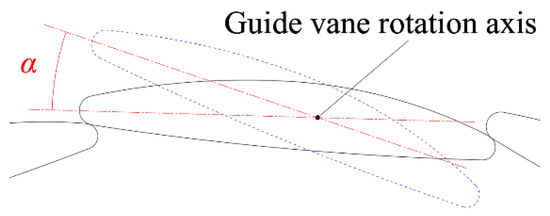
Figure 1.
Definition of GV opening angle α.
The 3D computational domain of the pump-turbine is shown in Figure 2. The domain was divided into five subdomains: (1) draft tube; (2) runner with 5 full-length blades and 5 splitters; (3) 16 guide vanes; (4) 16 stay vanes; (5) spiral casing. In pump mode, the inlet boundary was given on the low-pressure side of the draft tube, and the outlet boundary was given on the high-pressure side of the spiral casing.
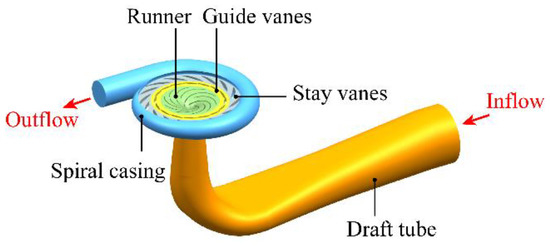
Figure 2.
Three-dimensional computational domains of the pump-turbine.
Previous studies [10] showed that only the torsional mode is involved during the GV vibration in the small opening range with pump flow. This implies that only the angular displacement of the GV stem, caused by the elastic deformation, occurs in this process. Given this, the flow in the spanwise of the GV blade, such as the leaking flow in the end-wall clearance and the vortex flow at the trailing edge, was identified as axial disturbance and not considered during the GV torsional vibration. Therefore, the two-dimensional (2D) approach was considered to be a valid approximation for the simulation of torsional vibration.
As shown in Figure 3, the 2D partial flow passage, containing one GV (shown in Figure 3 with red lines), was set as the computational domain of GV torsional self-excited vibration for relatively fine resolution and low cost. The influence of neighboring GVs on the torsional vibration could be neglected based on the comparative studies of the whole flow passage containing all GVs and the partial flow passage containing one GV, as mentioned in the reference [24]. The inlet boundary was between the runner and the GV. The outlet boundary was given on the outside of the GV and extended outward for a better boundary. The interfaces between neighboring GVs were set with rotational periodicities.
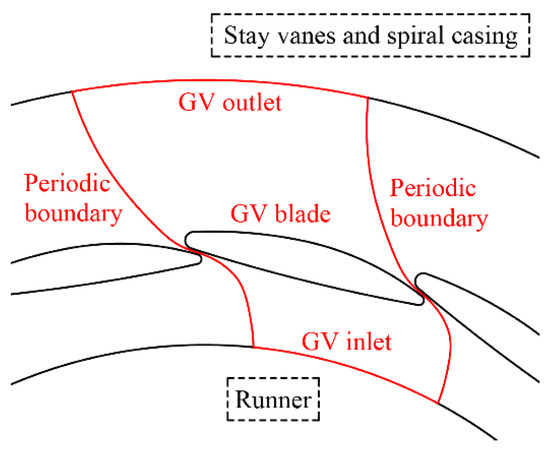
Figure 3.
Two-dimensional computational domains for GV torsional self-excited vibration.
Figure 4 shows the airfoil profiles and the parameter definitions of the original GV (GV-O) and the modified GV (GV-M). It should be noticed that the leading edge and the trailing edge of GV were defined according to the direction of pumping flow. The airfoil profile lines of GVs consist of arcs with different radials that were marked as variable R with subscripts, in which LE represents the leading edge, TE represents the trailing edge, H represents the high-pressure side, and L represents the low-pressure side. Point O represents the rotating axis of GV. The lchord is the chord length. The lLE is the length between the leading edge and the rotating axis, while lTE is the length between the trailing edge and the rotating axis. The overlapping shapes of the airfoils for GV-O and GV-M are drawn in Figure 5 when the GVs are fully closed. The main geometric parameters of the GV airfoil are listed in Table 2. The values of geometric parameters are relative to the reference radius Rref.
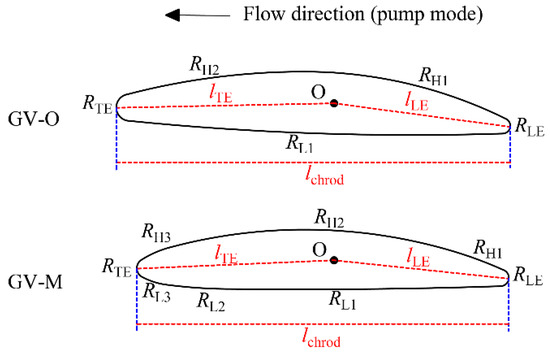
Figure 4.
Airfoil profiles and parameter definitions of GV-O and GV-M.

Figure 5.
Overlapping shapes of GV airfoil. (a) GV-O; (b) GV-M.

Table 2.
Main geometric parameters of GV airfoil shape against RLE-O.
2.2. Governing Equations and Numerical Settings
The unsteady Reynolds-averaged Navier-Stokes (URANS) solver in ANSYS CFX was used for the turbulent flow calculation. The mass conservation equation and momentum equation are shown as Equations (3) and (4), respectively, in both of which, all of the averaged bars are taken off except for the Reynolds stresses:
where ui (i = u, v, w) is the velocity, xi (i = x, y, z) is the position, t is the time, p is the pressure, μ is the dynamic viscosity, and SM is the external momentum source term. The turbulence model of k-ω shear stress transport [25] was utilized to model the Reynolds stresses. In this turbulence model, the Wilcox k-ω model [26] is used to calculate near-wall flow, and the k-ε model [27] is applied for the main flow area. This exploits the advantages of these two turbulence models and has a good behavior on the prediction of the onset and amount of flow separation. Water was set as the compressible fluid. Equations (8) and (9) were implemented to compute the density ρ and the speed of sound a, respectively. The reference density is denoted as ρref, pref is the reference (atmospheric) pressure, and B is the modulus of elasticity (2 × 109 Pa) at 20 ℃ of water and the atmospheric pressure [28].
The torsional vibration of a guide vane only involves the angular displacement, which is caused by the elastic deformation of the guide vane stem, as shown in Figure 6. The spanwise flow, caused by the flow separation at the trailing edge and the leaking flow in the end wall clearance, were identified as axial disturbance and not considered in this study. Thus, the two-dimensional (2D) approach was considered to be a valid approximation to simulate the torsional self-excited vibration. As shown in Figure 6, the flow-induced vibration in the torsional mode of GV was expressed by a single degree of freedom (1DOF) oscillator in the flow field [21,22]. The differential equation is:
where θ is the rotation degree of the single freedom, ζs is the structural damping ratio, is the angular velocity, M is the hydraulic torque, J is the mass moment inertia, and ωt is the natural circular frequency that is calculated as:
where K is the torsional stiffness. The structural damping ratio ζs is always positive and stabilizes the self-excited vibration. Thus, it was not considered in this study and neither was the other external damping such as that from the mechanical friction. This was considered to add a margin of safety and not affect the main issues in the current work. In any case, the severe hard excitation with a large initial amplitude hardly occurs during the starting-up process of a real pump-turbine unit. Thus, soft excitations were simulated by subtracting the static value from the total hydraulic torque in Equation (7).
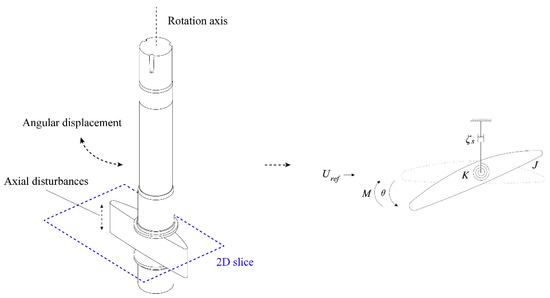
Figure 6.
Sketch of flow-induced vibration in the torsional mode of GV.
Steady simulations were carried out for two GVs under different operating conditions based on the 3D computation domain shown in Figure 2. The rotating frame by nd was set for the runner domain, while the stationary frame was set for the other domains. The rotating and stationary domains were connected through the interface modeling approach of multiple reference frames. Frozen rotor interfaces were applied for the steady simulations. The total pressure was set as the inlet boundary condition of the draft tube, while the static-pressure boundary condition was employed for the outlet of the spiral casing. The automatic near-wall treatment in ANSYS CFX was employed for the solid walls, which automatically switched from wall function to a Low-Reynolds near-wall formulation as the mesh was refined [29].
The rigid body solver in ANSYS CFX was used for the coupling simulations of GV self-excited vibration. Considering the very short vibration duration of the self-excited vibration process, stable total pressure with flow angle and stable opening pressure was set as the inlet and outlet boundary conditions, respectively. The 1DOF oscillator was formed by the mass-spring model, in which the torsional stiffness was calculated using Equation (8). The mass moment inertia and the torsional mode natural frequency were estimated by the modal analysis for the GV with a stem. In addition, the mesh is deformed with the displacement of the guide vane profile, instead of reconstructed. The time-step was applied with Δt = 1.875 × 10−4 s for adequate resolution to the response frequency. A detailed description of the numerical methodology can be found in [29].
2.3. Independence Test of Mesh Density
To evaluate the instability of self-excited vibration, the damping ratio was defined as:
where α is the GV opening angle. Subscript P and R represent two peaks with an interval of NT (N = 1, 2, …). T is the vibrating period, as shown in Figure 7. The negative damping ratio implies that the guide vane self-excited vibration is unstable.

Figure 7.
Definition of the damping ratio of torsional self-excited vibration.
The 3D domain was meshed using tetrahedral elements for the spiral casing and hexahedral elements for the other flow passage components. The schematic map of mesh in the runner, GV, and stay vane is plotted in Figure 8. The hexahedral mesh was also created in the 2D domain of the GV for the coupling simulation, as shown in Figure 9. Three meshing cases were used to evaluate the mesh resolution, in which the mesh density increased equally in all computational domains when changing the meshing scheme. The mesh resolution evaluation was conducted by the Grid Convergence Index (GCI) method based on the Richardson extrapolation [30]. The sufficient mesh resolution for GV-O under the operating condition of α = 0.2° and Cψ = 1.133 was assumed reliable enough to merit its extension to other cases. The flow rate coefficient Cφ and the damping ratio ζα were selected as the indexes (χ) in checking three different mesh schemes for the 3D CFD simulation and the 2D coupling simulation. Table 3 shows the grid convergence analysis for 3D and 2D cases. The convergence indexes of GCIfine21 are 6.380% for the 3D CFD simulation and 8.336% for the 2D coupling simulation, which are less than the 10% recommended [30]. The index values of fine meshes are close to the extrapolated values (χext21). Thus, the fine schemes satisfied the GCI check, which was considered tolerable in this study. The value of yplus, a classical non-dimensional distance for wall-bounded flow, was less than 30 for the solid walls of guide vanes and stay vanes.
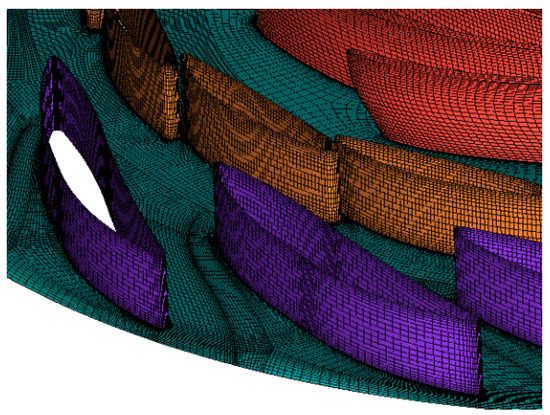
Figure 8.
Schematic map of the mesh used in 3D CFD simulation.
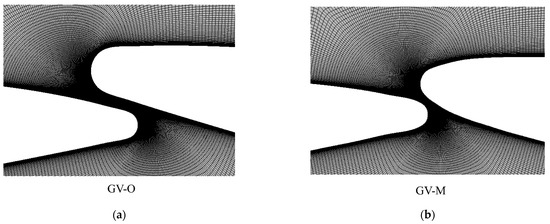
Figure 9.
Schematic map of the mesh used in 2D coupling simulation. (a) GV-O; (b) GV-M.

Table 3.
Grid convergence analysis based on the flow rate coefficient Cφ for 3D CFD simulations and the damping ratio ζα for 2D coupling simulations at α = 0.2° and Cψ = 1.133.
3. Results and Discussion
3.1. Simulated Conditions
To simulate the inter-vane flow regime at the small GV opening angle in pump mode, 3D steady simulations were carried out at the opening angle of α = 0.2°, 0.4°, 0.6°, 0.8°, and 1° for GV-O and GV-M. Considering the operating processes under different water level differences between the upstream and the downstream, the conditions that Cψ = 1.185, 1.133, and 1.067 were simulated at each opening angle. Figure 10 shows the flow rate coefficients under different operating conditions.

Figure 10.
Flow rate coefficient in pump mode with respect to GV opening angle under conditions of different head coefficients. (a) GV-O; (b) GV-M.
To evaluate the instability of GV torsional vibration, URANS-1DOF coupling simulations were conducted for GV-O and GV-M under the above operating conditions. Based on the 3D CFD results, the inlet boundary condition of GV was set as the average total pressure pt1 on the interface between runner and GVs, while the outlet boundary condition was given as the average static pressure ps2 on the interface between GVs and stay vanes. Figure 11 shows the pressure difference between the GV inlet and outlet, which is defined as:
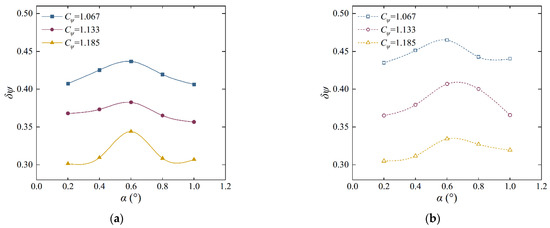
Figure 11.
Pressure difference coefficient between the inlet and outlet of GV with respect to GV opening angle under conditions of different head coefficients. (a) GV-O; (b) GV-M.
3.2. Inter-Vane Flow at Different Opening Angles
Figure 12 and Figure 13 show the flow field on the mid-section plane in the double-stage radial vane at different opening angles under the example condition of Cψ = 1.133. The static pressure coefficient Cp and the velocity coefficient Cv can be expressed as follows:
where p is the static pressure and v is the absolute velocity magnitude. We observe that:

Figure 12.
Contours of Cp and contours of Cv with vectors on the mid-section plane at different opening angles of GV-O under the condition of Cψ = 1.133.
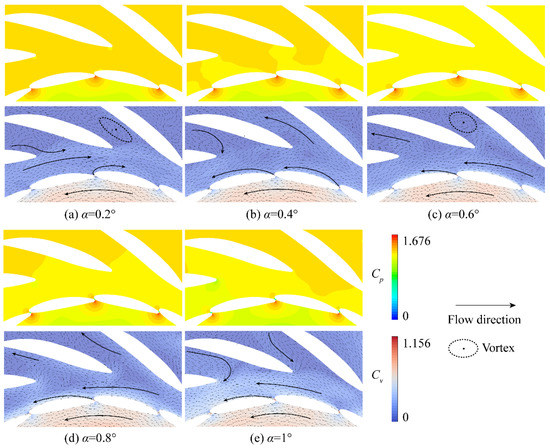
Figure 13.
Contours of Cp and contours of Cv with vectors on the mid-section plane at different opening angles of GV-M under the condition of Cψ = 1.133.
- The flow inside the GVs posed a high circumferential velocity component in the counterclockwise direction, which is consistent with the runner rotating direction. A local high-pressure region was formed at the leading edge of GV, which led to the high-speed flow through the inter-vane opening. This also caused a large drop in static pressure at the inter-vane opening.
- Two flow types were presented in the vaneless region between the GV blades and the stay vane blades. A flow circle rotating reversely against the runner rotation was formed in the vaneless region at a smaller opening angle, as shown in Figure 12a,b or Figure 13a. In this situation, the flow, passing through the inter-vane opening, attached to the trailing edge and merged into the counterclockwise flow circle. At larger opening angles, the jet flow through the inter-vane opening attached to the blade surface of the next GV. The flow in the vaneless region rotated in the same direction as the runner rotation.
The high-pressure difference between the inlet and outlet of the inter-vane opening was considered to cause the high-speed jet flow and the large pressure drop. This was also claimed to be the essential factor of the unstable self-excited vibration of GV in the torsional mode, as analyzed in [31]. Due to the high vibration frequency of self-excitation, the flow rate and the total pressure at the runner outlet were almost constant in this process.
The two flow types in the vaneless region were also reported by other studies on the pump mode of pump-turbine [7,10,20]. These studies claimed that two stable flow regimes might be formed in the situation of the same flow passage shapes and boundary conditions. The type of flow was considered related to the trailing edge diameter, the wake flow, and the phase relation between the two wake vortexes. Given this, the bi-stable flow in the GVs might also be induced due to the influence of airfoil shape, flow disturbance, GV vibration, etc. In the following coupling simulations of GV vibration, the two flow types and their influence on the GV torsional vibration were also focused even though the bi-stable flow regimes were not predicted in the 3D CFD simulations.
In addition, the large-scale vortexes in stay vane channels were caused by the low flow rate under the small opening ranges. Due to the low frequency (0.1 fn–0.4 fn) induced by the large-scale vortexes and the high frequency (15 fn–17 fn) of the torsional self-excited vibration, the influence of the large-scale vortexes in stay vane channels were not considered in the URAN-1DOF coupling simulations. The outlet boundary condition with stable static pressure was approximately valid for the 2D GV computational domain.
3.3. Inter-Vane Flow at Different Head Coefficients
Figure 14 shows the flow field on the mid-section plane in the double-stage radial vanes at different head coefficients under the example condition of α = 0.2° and α = 1° for GV-O. By comparing the contours of Cv with vectors, we find that the flow regimes in the vaneless region were similar for the conditions of different head coefficients: the flow circle rotated reversely against the runner rotation at α = 0.2° while in the same direction as runner rotation at α = 1°. By comparing the contours of Cp, we observe that the static pressure at the stay vane side is lower for Cψ = 1.067 than that for Cψ = 1.185. This implies that the pressure difference between the GV inlet and GV outlet is larger at Cψ = 1.067 for the conditions of the same opening angles, as shown in Figure 11a. Similar conclusions can also be drawn under other conditions, and are also valid for GV-M.
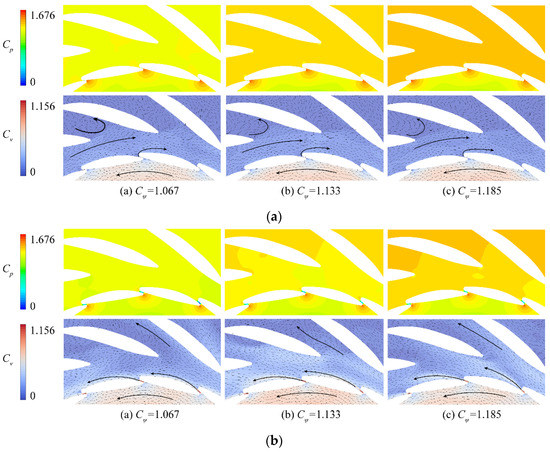
Figure 14.
Contours of Cp and contours of Cv with vectors on the mid-section plane head coefficients under the example condition of α = 0.2° and α = 1° for GV-O. (a) α = 0.2°; (b) α = 1°.
3.4. Inter-Vane Flow on Different Section Planes
Figure 15 shows the flow field on the different section planes in the double-stage radial vanes under the example condition of α = 0.2° and α = 1° at Cψ = 1.133 for GV-O. The GV height z* is expressed as z*= z/Rref, where z is the coordinate value in the vertical direction. The section plane z* = 0 is the horizontal mid-section plane of the double-stage radial vanes, while the section planes z* = 0.0757 and z* = −0.0757 are the section planes close to the head cover and bottom ring, respectively. The pressure distribution in the vaneless region presented good similarity on different section planes. The typical flow regime was also predicted on different section planes, including the flow circle in the vaneless region and the large-scale vortex in the stay vane channel. Similar conclusions can also be drawn under other conditions, and are also valid for GV-M. Thus, it can be concluded that the quasi-2D flow is valid in order to approximate the flow in the vanes. In any case, only the angular displacement of the GV stem occurred in the torsional vibration process. In summary, we can confirm that the 2D approach is valid for the simulation of torsional vibration.
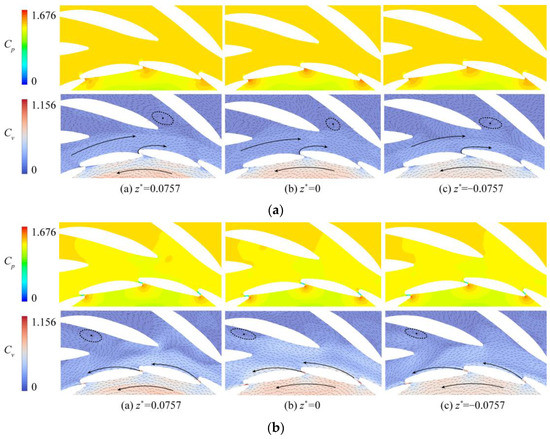
Figure 15.
Contours of Cp and contours of Cv with vectors on the different section planes under the example condition of α = 0.2° and α = 1° at Cψ = 1.133 for GV-O. (a) α = 0.2°; (b) α = 1°.
3.5. Influence of Flow Type in the Vanes on GV Self-Excited Vibration
As shown in Section 3.2, the bi-stable flow may be induced in the inter-vane at small GV opening ranges, which means that different flow types may be formed under the same operating condition. This may influence the vibration stability of GV in some opening conditions. According to the reference [20] and the 3D CFD results, the bi-stable flow may occur at smaller GV opening conditions, such as the α = 0.2° and α = 0.4° for GV-O and α = 0.2° for GV-M, as shown in Figure 12 and Figure 13. Given this, 2D steady simulations were carried out at these opening angles under the example condition of Cψ = 1.133. Two types of boundary conditions (BC) have been used for the inlet of GVs: the stable total pressure with flow angle (pressure BC) and the velocities with radial and circumferential components (velocity BC). Figure 16 shows the flow field in the double-stage radial vanes under different inlet boundary conditions. The following observations can be made:
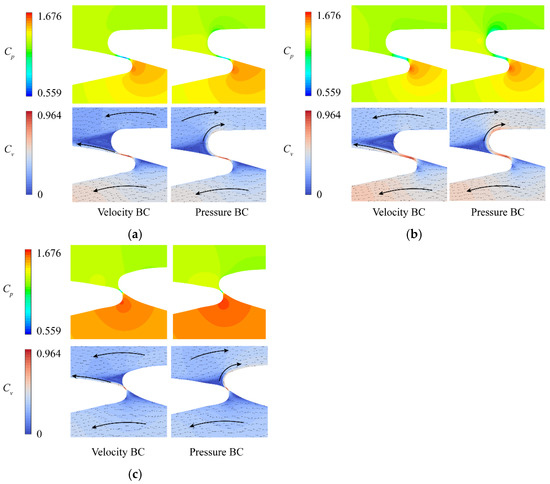
Figure 16.
Contours of Cp and contours of Cv with vectors at the example condition of Cψ = 1.133 under different inlet boundary conditions. (a) α = 0.2° for GV-O; (b) α = 0.4° for GV-O; (c) α = 0.2° for GV-M.
- In the situation of velocity BC, the jet flow through the inter-vane opening attached to the blade surface of the next GV, and was similar to the 3D CFD results at larger opening ranges.
- In the situation of pressure BC, the flow attached to the trailing edge after passing through the inter-vane opening and then merged into the clockwise flow circle at the outside of GV.
- Under pressure BC, the static pressure at the leading edge was larger while the flow rate through the inter-vane opening was lower than that under velocity BC.
Two flow types were simulated with different boundary conditions under the same condition of pressure difference δψ. According to the reference [20], the flow regimes under velocity BC and pressure BC were identified as Type Ⅰ and Type Ⅱ, respectively. In addition, we also found that the flow type Ⅱ with a flow deflection on the GV leading edge was formed under both velocity BC and pressure BC when adopting the coarse mesh scheme for the 2D computational domain. For the numerical simulation, this implies that insufficient mesh resolution and large numerical errors may have a non-negligible effect on the flow regime. Due to the limitation of computing resources, the mesh resolution in the double-stage radial vanes for 3D cases with 16 GVs and 16 stay vanes is much lower than that for 2D cases with partial flow passage containing one GV. Given this, the flow regimes in the vanes predicted by the 2D approach are considered more reliable despite simplifications in numerical methods and boundary conditions.
URANS-1DOF coupling simulations were conducted in the above operating conditions based on the initial flow field of Type Ⅰ and Type Ⅱ. Figure 17 shows the time history of GV opening angles during the vibration processes. The damping ratios of self-excited vibrations are listed in Table 4. It took less time for the initial disturbance to develop into high-amplitude vibration for the cases with an initial flow field of Type Ⅰ than that of Type Ⅱ. This suggests the initial flow field of Type Ⅱ may aggravate the vibration instability of GVs in the torsional mode. For the condition of α = 0.2° for GV-O, the self-excitation was stable in the Type Ⅰ case but become unstable in the Type Ⅱ case. In summary, the influence of flow type Ⅱ needs to be considered when evaluating the vibration stability of GVs in the torsional mode.
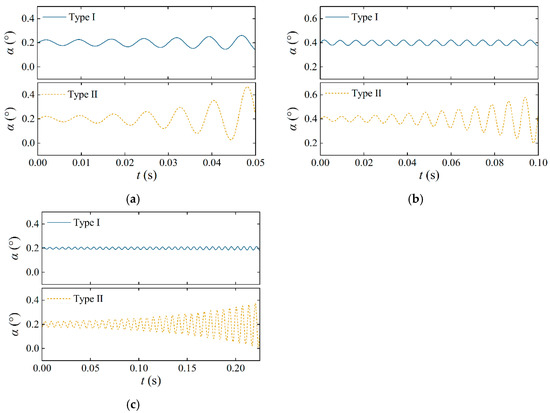
Figure 17.
Time histories of GV opening angle during the vibration processes. (a) α = 0.2° for GV-O; (b) α = 0.4° for GV-O; (c) α = 0.2° for GV-M.

Table 4.
Damping ratios of GV self-excited vibration with different initial values.
3.6. Torsional Vibration of Guide Vane in Site Tests and Verification of URANS-1DOF Coupling Simulation
Unstable torsional vibration of guide vanes normally occurs in prototype pump-turbines when operating in pump mode with small GV opening angles. In this situation, detailed observation of guide vane torsional vibration is difficult to conduct at this point. In this study, the URANS-1DOF coupling simulation was verified by the qualitative experimental evidence in the starting-up tests of a high-head pump-turbine. In the pump mode starting-up process, the ball valve starts to open after the rotating speed of the runner increases from 0 to 100%. After that, the GVs begin to open to a normal opening angle after keeping closed for 30–50 s.
Two different guide vane opening laws were used in the starting-up process for the prototype pump-turbine in this study. The static pressure in the vaneless space (the radial gap between the runner and the guide vanes) and the horizontal vibration of guide vane blades were monitored in these processes. Figure 18 and Figure 19 show the time histories of GV opening angles, the static pressure in the vaneless space, and the horizontal vibration velocity of guide vane blades for two site tests, respectively. By comparing Figure 18a and Figure 19a, we can observe: in site test 1, the guide vanes kept closed for about 45.5 s and then opened linearly to 70%; in site test 2, the guide vanes pre-opened to 5% after keeping closed for 30 s, and then kept for about 15.5 s and opened to 70%. These two different GV opening laws resulted in different pressure levels in the vaneless space within small GV opening ranges, as shown in Figure 18b and Figure 19b. By comparing the pressure pulsation in the vaneless space within a GV opening range of 0 to 5%, it can be observed that: the average pressure in the vaneless space in site test 1 is higher than that in site test 2; a high amplitude of pressure pulsation occurred under the smaller GV opening range of test 1; the amplitudes of pressure pulsation were low in site test 2 and under the larger GV opening range of site test 1. In addition, the guide vane with the largest vibration amplitude was chosen for use in evaluating the guide vanes vibrations in the pump-turbine. Figure 18c and Figure 19c show the horizontal vibration velocities of the guide vane blade within a GV opening range of 0 to 5%. In site test 1, especially under the smaller GV opening range, the horizontal vibration speed of the guide vane blade was markedly higher than that of site test 2. Main frequencies around 15.73 fn were found for the pressure pulsation in the vaneless space and the horizontal vibration of GV blade in smaller opening ranges of site test 1. This frequency component is consistent with the natural frequency of torsional mode for the GV in water. Therefore, the abnormal noise and pressure pulsation in the spiral casing in site test 1 are considered to be caused by the unstable GV torsional vibration at small opening angles. By Figure 18 and Figure 19, it is found that unstable GV torsional vibration and the high-pressure pulsation in the vaneless space are more likely to occur in the case with higher pressure level in vaneless space and a smaller GV opening angle. This risk was reduced when increasing the GV opening angle or decreasing the pressure levels in the vaneless space.
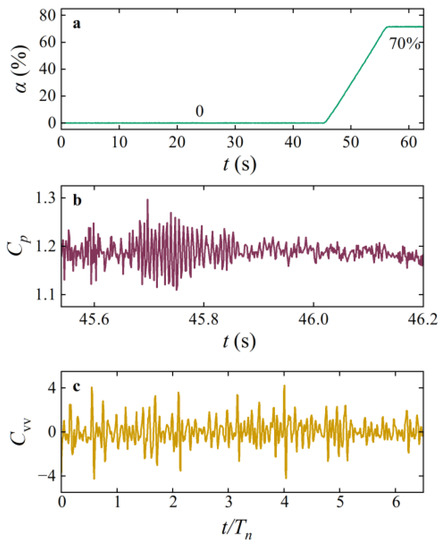
Figure 18.
Time histories of Main operating parameters in site test 1. (a) GV opening angle after the ball valve starts to open; (b) static pressure coefficient in vaneless space within a GV opening range of 0 to 5%; (c) α = 0.2° for GV-M horizontal vibration velocities of the guide vane blade within a GV opening range of 0 to 5%.
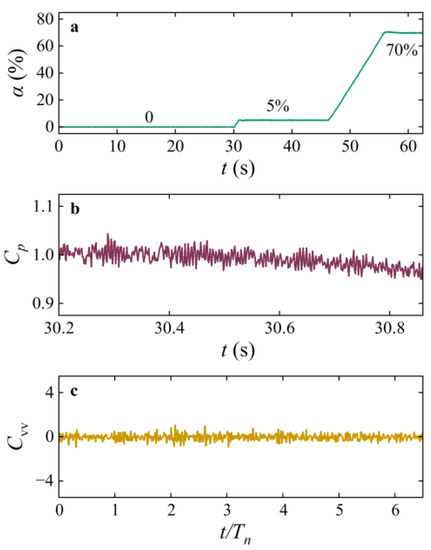
Figure 19.
Time histories of Main operating parameters in site test 2. (a) GV opening angle after the ball valve starts to open; (b) static pressure coefficient in vaneless space within a GV opening range of 0 to 5%; (c) α = 0.2° for GV-M horizontal vibration velocities of the guide vane blade within a GV opening range of 0 to 5%.
URANS-1DOF coupling simulations were conducted at different operating conditions based on the pressure difference coefficient in Figure 11. Figure 20 shows the damping ratio of GV-O under different GV opening angles with the head coefficient of Cψ = 1.133 and under different pressure differences between the GV inlet and outlet with the GV opening of α = 0.2°. The influence of the initial flow regime on GV self-excited vibration was also considered in Figure 20. Although the damping ratio value is different under the condition with two initial flow regimes, the tendency of the damping ratio with respect to GV opening angle or pressure difference would not be changed in these two situations: for the condition of Cψ = 1.133, the damping ratio changes from a negative value to a positive value with increasing GV opening angle, as shown in Figure 20a; for the condition of α = 0.2°, the damping ratio decreases with increasing pressure difference between the GV inlet and outlet, as shown in Figure 20b. These trends are consistent with the qualitative experimental evidence in site tests, which implies that the unstable self-excited vibration of GV-O is more likely to occur under the condition of smaller GV opening angles or higher-pressure levels in vaneless space. Given this, despite some assumptions such as the 2D approach and the rigid body model, the URANS-1DOF coupling method is considered valid for studying GV torsional vibration stability, at least qualitatively.
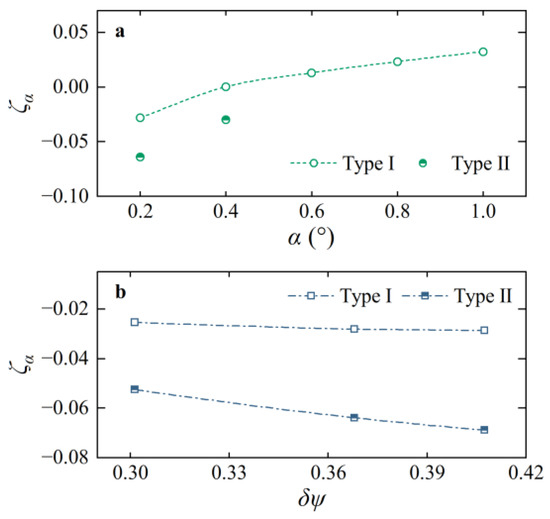
Figure 20.
Damping ratio of GV-O under different operating conditions: (a) under different GV opening angles with the head coefficient of Cψ = 1.133; (b) under different pressure differences between the GV inlet and outlet.
3.7. Analysis of the Torsional Vibration Stability for Two GVs with Different Airfoil Shapes
URANS-1DOF coupling simulations were conducted at different operating conditions based on the pressure difference coefficient in Figure 11. Figure 21 shows the damping ratios of self-excited vibrations calculated through the time histories of the GV opening angle. The semi-solid dots in Figure 21a and the hollow dots with small crosses in Figure 21b represent the damping ratios calculated with the initial flow field of Type II. Based on the analysis in Section 3.5, the initial flow field of Type Ⅱ may aggravate the vibration instability of GV in the torsional mode under the conditions of α = 0.2° and α = 0.4° for GV-O and α = 0.2° for GV-M. Thus, the damping ratios calculated with the initial flow field of Type II were applied for the evaluation of vibration stability under these operating conditions for a safety margin.
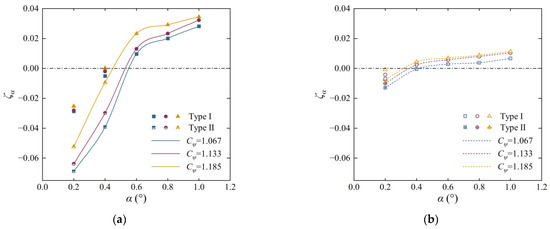
Figure 21.
Damping ratios of GV torsional self-excited vibration: (a) GV-O; (b) GV-M.
The solid curves in Figure 21a and the dashed curves in Figure 21b represent the variation trend of the vibration damping ratio of GV-O and GV-M with respect to the opening angle, respectively. We can observe that the variation range of the damping ratio of GV-O is greater than that of GV-M under the condition of small opening angles. Taking the condition of Cψ = 1.133 as an example, as the opening angle changes from 0.2° to 1°, the vibration damping ratio of GV-O changes from −0.0638 to 0.0323, while the damping ratio of GV-M changes from −0.01 to 0.0103. By comparing the damping ratio curves at different head coefficients, we observe that the vibration was more unstable in the situation of small head coefficients. This is due to the larger flow rate and the higher-pressure difference between the GV inlet and the GV outlet, as shown in Figure 10 and Figure 11.
According to the analysis in [24], the critical operating condition obtained by interpolating with ζα = 0 has a relatively large safety margin for the self-excited vibrations under steady-state operating conditions. Therefore, this method is adopted to calculate the critical opening conditions at different head coefficients. As shown in Figure 21, the horizontal coordinates of the intersection point of the damping ratio curve and the ζα = 0 line were interpolated to the critical opening conditions. Figure 22 shows critical opening angles vs. head coefficient for GV-O and GV-M. The vibration damping ratio is negative under the operating conditions below the curve of the critical opening angle. In these situations, the torsional vibration is unstable and may develop into a high-amplitude vibration. By contrast, the operating conditions above the curve of the critical opening angle are considered to be stable operating points.
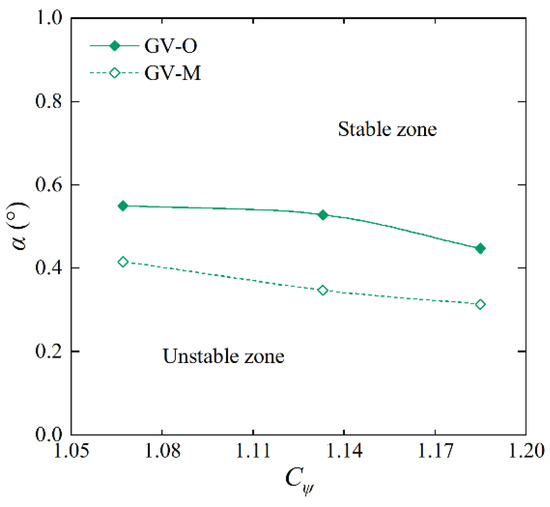
Figure 22.
Critical opening angles vs. head coefficient for GV-O and GV-M.
By comparing the curves of the critical opening angle, we can confirm that the self-excited vibration of GV-M is more stable than that of GV-O because of the small unstable zone for GV-M. However, the GVs are opened from 0 to the pre-opening angle or normal opening angle during the starting-up process of pump mode. This means that the GVs would pass through the unstable zone in Figure 22 for both GV-O and GV-M. Thus, the unstable self-excited vibration is weakened but not fully eliminated by modifying the profile of the GV airfoil. Nevertheless, the GV may have passed the unstable zone before the initial disturbance developed into a high-amplitude vibration. In this case, the torsional vibration is unstable but would not lead to the collision of neighboring GV blades. From this perspective, reducing the unstable zone by modifying the profile of the GV airfoil, or shortening the time of passing through the unstable zone by increasing the opening speed of GVs, are beneficial to avoid the collision of neighboring GV blades at the small opening angles in pump mode. These solutions have been used for the vibration problem of GV in Yixing pump-turbine [10]. In addition, according to the analysis of [24], increasing the end-wall clearance is beneficial in weakening the instability of self-excited vibration but unreliable for the collision of neighboring GV blades due to the uncertainty of the initial excitations and the relatively small end-wall clearances. According to the numerical and experimental analysis in [31], reducing the pressure level at the runner outlet by changing the GV operating process is effective for avoiding high-amplitude GV vibrations.
In summary, modifying the profile of GV airfoil or changing the GV operating process seems to be an efficient and reliable approach for weakening the torsional vibration instability. Yet the negative effects of these measures also need to be considered in the design and operation of pump-turbine. Modifying the airfoil profile may lead to a decrease of hydraulic efficiency in turbine mode and hydraulic stability in pump mode; changing the opening process of GVs may lead to large shaft power during the pressurizing process in pump mode.
4. Conclusions
The current study aimed to investigate the flow regime in the vanes and the torsional self-excited vibrations of GV under small opening angles of pump mode in a high-head prototype pump-turbine. Numerical studies based on the 3D CFD method and the URANS-1DOF coupling method were performed for two GVs with different airfoil shapes (GV-O and GV-M). Three-dimensional steady simulations of a pump-turbine show that two flow types were formed in the vaneless region between the GV blades and stay vane blades when operating at different opening angles. The flow regime with a deflection on the trailing edge and a circle in the vaneless region that rotated reversely against the runner rotation was presented at the conditions of α = 0.2° and α = 0.4° for GV-O and α = 0.2° for GV-M.
The influence of the inter-vane flow regime on GVs self-excited vibration was studied at the conditions of α = 0.2° and α = 0.4° for GV-O and α = 0.2° for GV-M. Adopting two types of inlet boundary conditions (pressure BC and velocity BC), 2D steady simulations show that two flow types are induced under the same condition of pressure difference δψ. The URANS-1DOF coupling simulations were conducted with initial flow fields of these two flow types. Results showed that the flow regime with a deflection on the trailing edge may aggravate the instability of torsional vibration when applied as an initial flow field.
By the qualitative experimental evidence in the starting-up tests of a high-head pump-turbine, the URANS-1DOF coupling simulation was verified and considered valid for studying GV torsional vibration stability. Then, coupling simulations were conducted at different operating conditions of the GV opening angle and head coefficient. Results showed that the torsional vibration was observed to be more unstable in the situation of small head coefficients owing to the larger flow rate and the higher-pressure difference between the GV inlet and the GV outlet. Furthermore, the critical opening angles at different head coefficients were obtained by interpolating with ζα = 0 for GV-O and GV-M. The torsional self-excited vibration of GV-M is considered more stable than that of GV-O because of the smaller unstable zone in the map of critical opening angle vs. head coefficient.
Author Contributions
Conceptualization, Q.L.; methodology, W.K. and L.Z.; software, W.K.; validation, Q.L.; investigation, Q.L., W.K. and L.Z.; writing—original draft preparation, Q.L.; writing—review and editing, L.Z.; visualization, Q.L. and L.Z.; supervision, Z.W.; project administration, L.Z. and W.K. All authors have read and agreed to the published version of the manuscript.
Funding
This work was supported by the National Natural Science Foundation of China (No.: 52079141).
Data Availability Statement
Not applicable.
Acknowledgments
Not applicable.
Conflicts of Interest
The authors declare no conflict of interest.
References
- Tagare, D. Electricity Power Generation: The Changing Dimensions; John Wiley & Sons, Inc.: Hoboken, NJ, USA, 2011. [Google Scholar]
- Rau, N. The State of Energy Storage in Electric Utility Systems and Its Effect on Renewable Energy Resources; No. NREL/TP-462-5337; National Renewable Energy Lab.: Golden, CO, USA, 1994. [Google Scholar]
- Zeng, W.; Yang, J.; Hu, J.; Yang, J. Guide-vane closing schemes for pump-turbines based on transient characteristics in S-shaped region. J. Fluid Eng. 2016, 138, 051302. [Google Scholar] [CrossRef]
- Li, D.; Wang, H.; Qin, Y.; Wei, X.; Qin, D. Numerical simulation of hysteresis characteristic in the hump region of a pump-turbine model. Renew. Energy 2018, 115, 433–447. [Google Scholar] [CrossRef]
- Oishi, A.; Yokoyama, T. Development of high-head single-and double-stage reversible pump-turbines. In Proceedings of the 10th IAHR Symposium on Hydraulic Machinery and Cavitation, Tokyo, Japan, 28 September–2 October 1980; pp. 441–452. [Google Scholar]
- Tanaka, H.; Tsunoda, S. The development of high head single stage pump-turbines. In Proceedings of the 10th IAHR Symposium on Hydraulic Machinery and Cavitation, Tokyo, Japan, 28 September–2 October 1980; pp. 429–440. [Google Scholar]
- Tao, R.; Zhou, X.; Xu, B.; Wang, Z. Numerical investigation of the flow regime and cavitation in the vanes of reversible pump-turbine during pump mode’s starting up. Renew. Energy 2019, 141, 9–19. [Google Scholar]
- Pacot, O.; Kato, C.; Guo, Y.; Yamade, Y.; Avellan, F. Large eddy simulation of the rotating stall in a pump-turbine operated in pumping mode at a part-load condition. J. Fluid Eng. 2016, 138, 111102. [Google Scholar] [CrossRef]
- Hasmatuchi, V.; Farhat, M.; Roth, S.; Botero, F.; Avellan, F. Experimental evidence of rotating stall in a pump-turbine at off-design conditions in generating mode. J. Fluid Eng. 2011, 133, 051104. [Google Scholar] [CrossRef]
- Nennemann, B.; Parkinson, E. YiXing pump turbine guide vane vibrations: Problem resolution with advanced CFD analysis. IOP Conf. Ser. Earth Environ. Sci. 2010, 12, 012057. [Google Scholar] [CrossRef]
- Potashnik, S. Some problems in operation of the Kiev pumped-storage station. Hydrotech. Constr. 1978, 12, 658–663. [Google Scholar] [CrossRef]
- Pulpitel, L. Self-excited vibration of pump turbine guide vanes. In Proceedings of the IAHR 11th Symposium on Hydraulic Machinery, Equipment and Cavitation, Amsterdam, The Netherlands, 13–17 September 1982. [Google Scholar]
- Zuo, Z.; Liu, S.; Sun, Y.; Wu, Y. Pressure fluctuations in the vaneless space of High-head pump-turbines—A review. Renew. Sustain. Energy Rev. 2015, 41, 965–974. [Google Scholar] [CrossRef]
- Zuo, Z.; Liu, S. Flow-induced instabilities in pump-turbines in China. Engineering 2017, 3, 504–511. [Google Scholar] [CrossRef]
- Kong, L. Analysis of abnormal sounds in working condition change-over for high-head pump-turbine. Mech. Electr. Tech. Hydropower Stn. 2004, 27, 12–14. [Google Scholar]
- Cai, J.; Zhou, X.; Deng, L.; Zhang, W. The research of the abnormal water hammer phenomenon based on the unit 3 over speed test of Jiangsu Yixing pumped storage power station. Water Power 2009, 35, 76–79. [Google Scholar]
- Bearman, P.; Wadcock, A. The interaction between a pair of circular cylinders normal to a stream. J. Fluid Mech. 1973, 61, 499–511. [Google Scholar] [CrossRef]
- Sumner, D.; Wong, S.; Price, S.; Paidoussis, M. Fluid behaviour of side-by-side circular cylinders in steady cross-flow. J. Fluid Struct. 1999, 13, 309–338. [Google Scholar] [CrossRef]
- Wang, Z.; Zhou, Y. Vortex interactions in a two side-by-side cylinder near-wake. Int. J. Heat Fluid Fl. 2005, 26, 362–377. [Google Scholar] [CrossRef]
- Ji, Q.; Wu, G.; Liao, W.; Fan, H. Flow deflection between guide vans in a pump turbine operating in pump mode with a slight opening. Energies 2022, 15, 1548. [Google Scholar] [CrossRef]
- Münch, C.; Ausoni, P.; Braun, O.; Farhat, M.; Avellan, F. Hydro Elastic Behavior of Vibrating Blades. In Proceedings of the 24th Symposium on Hydraulic Machinery and Systems, Foz do Iguassu, Brazil, 27–31 October 2008. [Google Scholar]
- Münch, C.; Ausoni, P.; Braun, O.; Farhat, M.; Avellan, F. Fluid–structure coupling for an oscillating hydrofoil. J. Fluids Struct. 2010, 26, 1018–1033. [Google Scholar] [CrossRef]
- Nennemann, B.; Sallaberger, M.; Henggeler, U.; Gentner, C.; Parkinson, E. Assessment of guide vane self-excitation stability at small openings in pump flow. IOP Conf. Ser. Earth Environ. Sci. 2012, 15, 062032. [Google Scholar] [CrossRef]
- Liang, Q.; Kang, W.; Zhou, L.; Wang, Z. Influence of End Wall Clearance on Guide Vane Self-Excited Vibrations at Small Openings during Pump Mode’s Starting Up Process of a Reversible Pump Turbine. J. Mar. Sci. Eng. 2022, 10, 528. [Google Scholar] [CrossRef]
- Menter, F. Two-equation eddy-viscosity turbulence models for engineering applications. Aiaa J. 1994, 32, 1598–1605. [Google Scholar] [CrossRef]
- Wilcox, D. Reassessment of the scale-determining equation for advanced turbulence models. Aiaa J. 1988, 26, 1299–1310. [Google Scholar] [CrossRef]
- Launder, B.; Sharma, B. Application of the energy-dissipation model of turbulence to the calculation of flow near a spinning disc. Lett. Heat Mass Transfer. 1974, 1, 131–137. [Google Scholar] [CrossRef]
- Trivedi, C. Investigation of compressible turbulent flow in a high-head Francis turbine. J. Fluid Eng. 2018, 140, 011101. [Google Scholar] [CrossRef]
- ANSYS. ANSYS CFX-Solver Modeling Guide: Release 18.0; Ansys Inc.: Canonsburg, PA, USA, 2017. [Google Scholar]
- Celik, I.; Ghia, U.; Roache, P.; Freitas, C. Procedure for estimation and reporting of uncertainty due to discretization in CFD applications. J. Fluid Eng. 2008, 130, 078001. [Google Scholar] [CrossRef]
- Kang, W.; Liang, Q.; Zhou, L.; Wang, Z. Numerical investigation on torsional self-excited vibration of guidevane in a reversible pump-turbine during pump mode’s starting up. J. Appl. Fluid Mech. 2022, 15, 1789–1799. [Google Scholar]
Publisher’s Note: MDPI stays neutral with regard to jurisdictional claims in published maps and institutional affiliations. |
© 2022 by the authors. Licensee MDPI, Basel, Switzerland. This article is an open access article distributed under the terms and conditions of the Creative Commons Attribution (CC BY) license (https://creativecommons.org/licenses/by/4.0/).